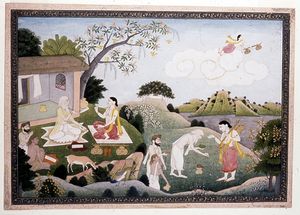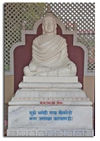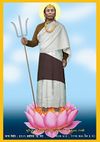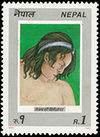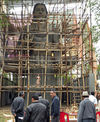By Himanshu Bhatt
The Vanavāsis or Ādivāsis are known by various other names such as Atavikās in Sanskrit literature and in Gandhian terms are known as Raniparaj, Vanyajāti and Girijan. Another popular term is Vanavāsi.
From the time of the Ṛgveda it is known that tribal groups outside the Indian caste system were the devotees of Hinduism. The caste system plus the Vanavāsis that caste-members were in contact with in the Vedic Age, is known as panca-manuṣyajātani and Agni Deva is "the chief priest of the five classes".[1]
There are several classes of Ādivāsi priests. Some tribals like the Vankar call their priests as Brahmin. Some Hindu groups like the Ārya Samaj adopted this Ādivāsi practice and began calling Ādivāsi priests as Garo Brahmans. Many great Hindu pilgrimages have Vanavāsis priests or clerics. For example, At the Lingaraj Temple in Bhubaneswar, there are Brahmin and Badu[2] priests. The Badus have the most intimate contact with the deity of the temple and only they can bathe and adorn it.[3][4] Chhotoloks haave their Lays as priest, Bhopa and Dewalo for Bhils, while for Santals the Kadam Naik and majhi-haram[5] are priests while the jog-majhi is the assistant headman and then the Kharias' preist are known as Kalo, Dehuri or Pahan and the priest assistant is the Pujar. Some famous temples have a local tribal god(dess) as the deity. An example is Devgarh Panchmari Vindhyachal Ashram, the story behind which is that Parvati as a Gondni (Gond tribeswoman) attracted and made happy Bara Dev (Shankar Diganmbar)[6], probably a Rudra-tribe monk. An idol of Parvati in the form of 'Muula Gondan' is still worshipped in the temple.
There were several kings and chiefs of kingdoms and tribes that accepted Hinduism and endorsed it peacefully amongst their subjects and tribesmen. An example of a prominent Vanavāsi figure is King Kriṣṇa Chandra, first Kachari to formally convert to Hinduism. Another is King Pamheiba of Manipur accepted Vaiṣnavism from Ramanandi Shantidas Gosain and took the title Garib Niwaz. Also in Manipuri history of importance is King Bhagyachandra of Manipur, who was converted by Rāmnārayaṇa Misra, a descendant of Chaitanya's uncle. King Govinda Manikya also converted to Vaiṣnavism. King Parvata Raya of Jaintia Khasis was important amongst Khasis. Even in the Hindu scriptures like Mahābhārata mention is made of Pāndava warrior prince Bhima marrying Hidimba.
Some Hindus believe that Indian tribals are close to the romantic ideal of the ancient silvan culture[7] of the Vedic people. Madhav Sadashiv Golwalkar said:
The tribals "can be given yajñopavîta (…) They should be given equal rights and footings in the matter of religious rights, in temple worship, in the study of Vedas, and in general, in all our social and religious affairs. This is the only right solution for all the problems of casteism found nowadays in our Hindu society."[8]
Several scriptures make mention to noble Vanavāsis. For example, the Bhils are mentioned in the Mahābhārata. The Bhil boy Ekalavya's teacher was Droṇa, and he had the honor to be invited to Yudhisthira's Rājasuya Yajna at Indraprastha.[9] Indian tribals were also part of royal armies in the Rāmāyana and in the Arthaśāstra.[10] In Hindu stories also, God or gods take the form(s) of tribals sometimes. In Baiga folklore, Mahādev (Śiva) and Parvati take the form of a Baiga and Baigin[11] Some saints amongst tribal communities are also worshiped as a god. For example, Balnathji Mahadeo the Koli saint is considered an avatār of Śankaravatar at Junagarh, Gujarat.
On a comparison to the tribals of other countries and regions, S.C. Dube notes "Their position, however, cannot be compared to that of Australian aborigines, American Indians or native Africans." This indicates that their status and economic position is higher in society. On the topic of Australian aboriginees, Graeme R. Kearsley had written that Gonds had emigrated from India to Australia, taking their culture with them, and eventually reached the Americas.[12]
Saintly development amongst Ādivāsis[edit]
Several devotional movements were embraced by Indians, and many times included the Vanavāsis as sectarian reformers or founders. For example, speaking of the Vaiṣnava movement in Asom, Sant Madhavadeva says The Vaiṣnava Order in its primal glory saw "the Garo, Bhota and Yavana (Muslim) saying prayers to Hari" and "the Miri, Asama and Kachari securing salvation through Rama-Nama"[13]
| Of the irrelevance of caste, especially in terms of religion Basava Swami said the following:[14] | In the Bhakti Era, saints from menial occupations continued work in their menial positions while also challenging barriers and worship God. The Varkāri sect Sant Eknath writes of the non-Dwija saints:[15] | ||||||
|---|---|---|---|---|---|---|---|
|
|
|
The saints of Vanavāsi communities have formed several devotional sects. Amongst the Bhils, the popular ones unique to Bhils are Shambhu Dal (Śaiva) and Rāma Dal (Vaiṣnava.) Amongst the Vanavāsi communities of Central India and Jharkhand, after the Bhakti Era had ended, there prospered the Bhagat Movement and amongst its foundations were the Bachhidan Bhagat, Bhuiphut Bhagats, Birsa Bhagats, Gau Rakshni Bhagat, Kamru Bhagat, Mahadeo Bhagats, Neha Bhagat, Tana Bhagats, and Viṣṇu Bhagats.
During the British colonial era in India, amongst the Vanavāsi communities there prospered a great time of devotion in which the Vanavāsi tried to preserve their identity from being lost to an alien religion so they established their own Hindu sects to counter the advancement of the foreign religions. In this era some popular saints began popularizing mainstream Hindu customs for their own tribe brethren. For example, Sant Jatra Oraon and his followers began wearing the sacred thread as a symbol of the purity of their faith.[16] "The Bhagat movement of various types aimed to purify the religious and social life of tribals on the model of higher form of Hinduism." Some Vanavāsi saints were converts who left foreign religions to come to Hinduism and revive their true ethical tribal ways. An example is Birsa Munda of the Munda tribe in Central India.[17] Saints like Haribaba also, not only spread Hindu popular worship and practices like vegetarianism but encouraged the wearing of a scared thread.
Also during colonialism these tribal Hindu movements worked closely with bigger and well-known Hindu activist groups whose mission was to educate the tribals. For example, Jeebon Roy was a Gandhian Indian freedom fighter and writers of some books detailing the lives of prominent Hindu figures like Chaitanya, Gautama Buddha, and Kṛṣṇa. Some of his works were Ka Kitap Chaitanya, Ka Rāmāyaṇa, Budhadev Charitra, Hitupodesa, Ka Niom Ki Khasi, Shaphang Uwei U Blei. His sons Sibcharan Roy and Chandranath Roy continued his legacy and translated Hindu scriptures like Bhagavad Gitā, Chanakya Niti Darpan. Atram Ramu and Kotnaka Jalim Shah of the Gond tribe of of Gunjala translated a simplified version of the Ramayana from the Marathi of a printed pamphlet into Gondi and distributed handwritten copies to several villages.
[edit]
A sant is an Indian holy man, and a title of a devotee or ascetic, especially in north and east India. Generally a holy or saintly person is referred to as a mahatma, paramahaṅsa, or swami, or given the prefix Śri or Śrila before their name.
| Name | Ethnicity | Tribe | Sect | Compositions | Other significance |
|---|---|---|---|---|---|
| Balai | Mikir | Mikir | Vaiṣnava (Ekasarana Dharma) | He was a disciple of Śankardev and preached the message Vaiṣnavism to gain devotees.[18] | |
| Balnathji Mahadeo | Gujarati | Koli | Śaiva | Avatār of Shankaravatar at Junagarh | |
| Bedara Kannappa | Kannada | Śaiva | An avatār of a Gandharva that had accidentally killed a deer in heaven.[19] He established the famous temple of Srikalahasti, Andhra Pradesh. | ||
| Bhadurdasa | Gujarati | Koli | A 17th or 18th century saint.[20] | ||
| Bhagirath Manjhi | Santal | Santal | Vaiṣnava | He encouraged, vegetarianism, non-alcoholism, worship of Viṣṇu, and opposing British rule amongst the Santals. | |
| Bhima Bhoi | Oriya | Bhoi | Vaiṣnava (Mahima Dharma) | His compositions (compiled by someone else but composed by him) are Stuti Chintamani, Brahmanirupana Gita, Adianta Gita, Chautisa Granthamala, Nirveda Sadhana, Sruti Nisedha Gita, Manusabha Mandala, Mahima Vinoda, Brihat Bhajana Mala and Bangala Atha Bhajan. | He was the principle disciple of Mahama Swami (Mukanda Das) and himself was a blind poet. |
| Bhrisundin | Koli | Ganpatya | Siddheswarsastri Chitrav wrote of him in the Ganesh Purana. | ||
| Bibi[1] |
Maithili | Kangjar | She is also worshiped in Bhagalpur. | ||
| Birsa Bhagwan (also Birsa Munda) |
Munda | Munda | Vaiṣnava | He is considered an avatar of Khasra Kora. People approached him as Singbonga, the Sun god. His sect included Christian converts.[2] He and his clan, the Mundas, were connected with Vaiṣnava traditions as they were influenced by Sri Chaitanya.[3] Birsa was very close to the Panre brothers Vaiṣnavites. He went to the extent of attacking churches and police station during his 1989-1990 Munda Rebellion.[21] | |
| Budhu Bhagat | Kol | Kol | Vaiṣnava | Led the Kol Insurrection (1831–1832) aimed against tax imposed on the Kol community by Muslim rulers.[21] | |
| Dhanraj Lodha | Bhil | Bhil | He was the son of Shreshthi Shrang Lodha. | ||
| Dhudhalinath | Gujarati | Koli | A 17th or 18th century devotee (P. 4, The Story of Historic People of India-The Kolis) | ||
| Dubia Gosain | Santal | Santal | Vaiṣnava | ||
| Ganga Narain | Hindi | Bhumij | Vaiṣnava | Led the Bhumij Revolt (1832–1833) aimed against missionaries and British colonialists. | |
| Gheru Lal Bal Chand (also Gheru Lal Tantia) |
Tantia | Tantia | Vaiṣnava | He managed Gandhi's ashram in Sirsa and was a freedom fighter. | |
| Girnari Velnathji | Gujarati | Koli | Of Junagadh, a 17th or 18th century devotee[20] | ||
| Govinda | Garo | Garo | Vaiṣnava (Ekasarana Dharma) | He was a disciple of Śankardev and preached the message Vaiṣnavism to gain devotees.[18] | |
| Govind Gir | Santal | Santal | Vaiṣnava | ||
| Govind Guru | Bhil | Bhil | Vaiṣnava | He led the Bhil uprising of southern Rajasthan against the British colonialists in 1913.[21] | |
| Gulia Bhamda | Marwadi | Bhil | |||
| Gunabhiram Barua | Barua | Barua | Brahma Dharma | He was a major disciple of Gurudev Kalicharan Brahma, and spread the Brahma Dharma to his capacity. | |
| Haipou Jadonang | Zeliangrong | Naga (Rongmei) |
Vaiṣnava (Heraka)[22] |
He was a Gandhian and often equated his Heraka sect with Vaiṣnavism. | |
| Haribaba (also Duka Ho) |
Ho | Ho | Vaiṣnava | He was a Gandhian that encouraged his tribesmen the Ho to give up alcohol, and to practice vegetarianism and Vaiṣnava worship. | |
| Jato Tamaria | Ho | Ho | Vaiṣnava | He was a disciple of Haribaba and spread Haribaba's teachings of vegetarianism, non-alcoholism, and Vaiṣnavism.[23] | |
| Jatra Oraon | Oraon | Oraon | Śaiva[24] | He claim that he received a dream from God whom told him to do away with animal sacrifices and the worship of ghosts.[25] led the Tana Bhagat Movement (1914–1919) aimed against the missionaries and British colonialists. | |
| Jayarama (also Jayanta Hari) |
Bhutiya | Bhutiya | Vaiṣnava (Ekasarana Dharma) |
He was a disciple of Śankardev and preached the message Vaiṣnavism to gain devotees.[18] | |
| Joria Bhagat | Gujarati | Nayak | He fought the British in his Naikdas Revolt of 1958-59, and 1968 with his comrade Sant Rup Singh, trying to establish a 'Dharam Raj'.[21] | ||
| Kaladutaka (also Vaikunthanatha) |
Tamil | Kallar (Robber) |
Vaiṣnava | He is considered an avatār of Lord Viṣṇu.[4] | |
| Kalicharan Brahma (also Guru Brahma) |
Bodo | Bodo | Brahmo Samaji | He founded the Brahma Dharma aimed against Christian missionaries and British colonialists. The Brahma Dharma movement sought to unite peoples of all religions to worship God (Brahma) together and survives even today. | |
| Kalu Dev | Punjabi | Nishadha (Fisherman) |
|||
| Kannappa Nayanar[5] (also Dhira) |
Tamil | Śaiva | One of 63 Nayanar Śaivite sants, a hunter from whom Lord Śiva gladly accepted food offerings. It is said that he poured water from his mouth on the Śivlingam and offered the Lord swine flesh.[6] | ||
| Kartikeya (Skanda) | Guha (Mattamayuraka/Krittika) | He aided the Devas against the Asuras in many battles and became their army-commander. (Hence, the epithet Mahasena.)
| |||
| Kiratarjuniya (also Kirata) | Kirat (Hunter) |
The form of Lord Śiva as a hunter. It is mentioned in the Mahābhārata. The Karppillikkavu Sree Mahadeva Temple, Kerala adores Lord Śiva in this avatār and is known to be one of the oldest surviving temples in Bharat. | |||
| Koli Bhagat | Gujarati | Koli | Vaiṣnava | He introduced Vaiṣnavism to the Koli community of Chotila, Gujarat. | |
| Kotnaka Suru | Gond | Gond | Vaiṣnava | He taught methods for attaining mokṣa, and began the Shri Guru Dev Seva Mandal. | |
| Koya Bhagat | Gujarati | Koli | A 17th or 18th century devotee[20] | ||
| Kubera | Yaksha | ||||
| Kubera | Gujarati | Koli | Vaiṣnava | He was a saint of Sarsa, taught for over 35 years, and had 20,000 followers in his time.[26] | |
| Madan Bhagat | Gujarati | Koli | He was a 17th or 18th century saint.[20] | ||
| Te-Ongsi Sirijunga Dewangsi | Limbu | Limbu | Yuma | Mundhum | He spread the message of the oral tradition or mantras and incantations called Mundhum to other Limbus in Sikkim in the 18th century. He was the first one to compile the entire Mundhum. |
| Mangai Alvar | Tamil | Kallar | Vaiṣnava | He composed the six Vedangas in beautiful Tamil verse.[7] | |
| Mangru Kharsawan | Vaiṣnava | ||||
| Narahari | Ahomi | Ahomi | Vaiṣnava (Ekasarana Dharma) |
He was a disciple of Śankardev and preached the message Vaiṣnavism to gain devotees.[18] | |
| Narasimha | Śabara | He slew Hiranyaksha for being a tyrannical emperor. | |||
| Narottama | Nocte | Naga (Nocte) | Vaiṣnava (Ekasarana Dharma) |
He was a disciple of Śankardev and preached the message Vaiṣnavism to gain devotees.[18] | |
| Parmananda | Mishing | Miri or Mishing | Vaiṣnava (Ekasarana Dharma) |
He was a disciple of Śankardev and preached the message Vaiṣnavism to gain devotees.[18] | |
| Phalagunanda Lingden | Limbu | Limbu | Jasmini Sadhu | He spread his message in Sikkim. | |
| Pipa Bhagat | Gujarati | Koli[27] | Vaiṣnava | He served under-privileged and down-rotten people. | |
| Pran Dhamin[8] |
Maithili | Kangjar | He is also worshiped in Bhagalpur. | ||
| Ramai | Kachari | Kachari | Vaiṣnava (Ekasarana Dharma) |
He was a disciple of Śankardev and preached the message Vaiṣnavism to gain devotees.[18] | |
| Ramdas | Marwadi | Bhil | Vaiṣnava | ||
| Ramdev Ata | Ata | Ata | Vaiṣnava | He was a great devotee that spread much of his lifetime spreading Vaiṣnavism, encouraging vegetarianism and non-violence. He converted the Nocte chief Khunbao, also known as Lotha Khunbao, who is the ancestor of the present chiefs families of Namsang, Borduria and Laptang, when Shri Ram Dev Ata was the Adhikar (Abbot) of the Satra. | |
| Rameswara Prasad (also Gadhara Guru) |
Hindi | Kavar | Vaiṣnava | He was the guru of 80,000 Kavar brethren and later joined Swami Satyamitranandji.[28] He also established the 'Sanatna Sant Samaj' Hindu organization. | |
| Rani Gaidinliu | Zeliangrong | Naga (Rongmei) |
Vaiṣnava (Heraka)[29] |
She took over the priesthood of Heraka and was important in its resistance to British colonialists and Christian missionaries. She said, "I built temples because the Bhuban told me in a dream that there would be prosperity and good health for every one if I did so, although it is not our custom to build temples. The male god in my upper temple is Vishnu."[30] | |
| Rup Nath Brahma | Bodo | Bodo | Brahma Dharma | He was the chief disciple of Gurudev Kalicharan Brahma, and spread the Brahma Dharma to his capacity. | |
| Śabaraveṣvara | Śabara | He defeated fellow-Śabara Narasimha for having assassinated Hiranyaksha. | |||
| Śabari | Śabara | She was a woman disciple of Matanga, who offered Rama and Lakshmana jujubes when they were searching for Sita in the forest. | |||
| Sany Kanji Swami | Gujarati | Koli | A 17th or 18th century devotee[20] | ||
| Surmaldas | Gujarati | Bhil | Vaiṣnava (devotee of Rāma) |
||
| Tantya Mama | Bhil | Bhil | She is after whom a movement is named after – the "Jananayak Tantya Bhil." | ||
| Tilihadano[9] |
Maithili | Kol | He is also worshiped in Bhagalpur. | ||
| Valmiki (also Ratna Vailya) |
Bhil | Vaiṣnava (devotee of Rāma) |
He composed the Rāmāyaṇa, and is considered to be an avatar in the Balmiki community and some Vaiṣnava scriptures like Viṣnudharmottara Purāṇa.[31] | ||
| Valram | Gujarati | Koli | A 17th or 18th century saint.[20] | ||
| Vettakkorumakan | Kirata (Hunter) |
The son of Lord Kirata. | |||
| Vishvanath Maharaj | Hindi | Dhanak Tadvi | Vaiṣnava |
Related Articles[edit]
References[edit]
- ↑ RV IX.66.20
- ↑ It means tribal.
- ↑ JAIN, Girilal: The Hindu Phenomenon. UBSPD, Delhi 1994.
- ↑ Eschmann, Kulke and Tripathi, eds.: Sect of Jagannath, p.97. Elst 2001
- ↑ It refers to headman.
- ↑ P. 128 Process of social change among tribes By Sita Ram Sharma
- ↑ Thomas Parkhill: The Forest Setting in Hindu Epics.
- ↑ M.S. Golwalkar: Bunch of Thoughts, p.479.
- ↑ Mahābhārata (I.31–54) (II.37.47; II.44.21) Elst 2001
- ↑ Kautilya: The Arthashastra 9:2:13-20, Penguin edition, p. 685. Elst 2001
- ↑ P. 5 Man, Forest And The State In Middle India By Sachchidananda, Nīraja Kumāra Caturvedī
- ↑ P. 61 Inca Origins: Asian Influences in Early South America in Myth, Migration and History By Graeme R. Kearsley
- ↑ P. IX Early history of the Vai??ava faith and movement in Assam : Saṅkaradeva and his times by Maheswar Neog
- ↑ P. 480 A Sourcebook of Indian Civilization edited by Niharranjan Ray, Brajadulal Chattopadhyaya
- ↑ P. 42-43 Living Through the Blitz By Tom Harrisson
- ↑ P. 149 The Unrest Axle: Ethno-social Movements in Eastern India edited by Gautam Kumar Bera
- ↑ Tribal Movements in Jharkhand, 1857-2007 edited by Asha Mishra, Chittaranjan Kumar Paty
- ↑ 18.0 18.1 18.2 18.3 18.4 18.5 18.6 P. 108, Historical Researches Into Some Aspects of the Culture and Civilization of By G. P. Singh
- ↑ P. 120 Routledge Handbook of Indian Cinemas edited by K. Moti Gokulsing, Wimal Dissanayake
- ↑ 20.0 20.1 20.2 20.3 20.4 20.5 (P. 4, The Story of Historic People of India-The Kolis)
- ↑ 21.0 21.1 21.2 21.3 P. 47 Sura's Year Book 2006 (English) By V.V.K.Subburaj
- ↑ P. 99 Historical Researches Into Some Aspects of the Culture and Civilization of North-East India By G. P. Singh
- ↑ P. 349 Ethnopolitics and identity crisis by Buddhadeb Chaudhuri
- ↑ P. 140 The Unrest Axle: Ethno-social Movements in Eastern India edited by Gautam Kumar Bera
- ↑ P. 158 Tribal society in India: an anthropo-historical perspective by Kumar Suresh Singh
- ↑ P. 269 Brahmanism and Hinduism, Or, Religious Thought and Life in India: As Based on the Veda and Other Sacred Books of the Hindus (Google eBook) by Monier-Williams
- ↑ P. 122 Gazetteers: Amrel District by Directorate of Government Print., Stationery and Publications, 1972
- ↑ P. 114 Manthan, Volume 5 by Deendayal Research Institute, 1983
- ↑ P. 99 Historical Researches Into Some Aspects of the Culture and Civilization of North-East India By G. P. Singh
- ↑ P. 215 Nagas Struggle Against the British Rule Under Jadonang and Rani Gaidinliu, 1925-1947 by Asoso Yonuo
- ↑ P. 166 Mythology of Viṣṇu and His Incarnations By Manohar Laxman Varadpande

